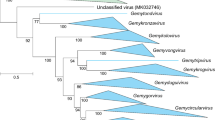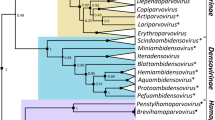Summary
Gene-by-gene phylogenetic analyses of all of the viruses for which sequences are known, as well as analysis of the coding capacities, clearly demonstrated that there are two major groups of viruses in the taxonomic familyGeminiviridae. These are of the Subgroup I type, with one genomic component, which mainly infect monocots and are leafhopper-transmitted; and of the Subgroup III type, with one or two genomic components, which infect dicots and are whitefly-transmitted. The existence of “New World” and “Old World” clusters of Subgroup III viruses was confirmed, as well as the possession by the latter of an AV1 ORF not present in New World viruses. A third minor generic group is defined by viruses of the Subgroup II type, which have a single genomic component, infect dicots, and are leafhopper-transmitted. The latter group appear to be the result of an ancient recombination event between a Subgroup III-like and a Subgroup I-like virus. The question of whether one- and two-component Subgroup III viruses should be in the same taxon appears hard to resolve: the only distinguishing feature of the one-component Subgroup III viruses is that they apparently have no second component, as gene-for-gene comparisons of the “A” components of the viruses with other Subgroup III viruses place them within a larger Old World group of viruses, most of which are two component. The possibility exists that these viruses may either have independently lost their B components, or possess a B component that has simply not yet been found. Possible nomenclatural changes to accommodate viruses with the same name which are not closely related to one another, and possible evolutionary scenarios to account for the observed familial, generic and specific diversity of geminiviruses, are discussed.
Similar content being viewed by others
References
Allison RF, Janda M, Ahlquist P (1989) Sequence of cowpea chlorotic mottle virus RNA-2 and RNA-3 and evidence of a recombination event during bromovirus evolution. Virology 172: 321–330
Boulton MI, Markham PG (1986) The use of squash-blotting to detect plant pathogens in insect vectors. In: Jones RAC, Torrance L (eds) Developments in applied biology I: Developments and applications in virus testing. Association of Applied Biologists, Wellesbourne, pp 55–69
Briddon RW, Markham PG (1994) FamilyGeminiviridae. In: Fauquet CM et al. (eds) Classification and Nomenclature of Viruses. 6th Report of the International Committee on Taxonomy of Viruses. Springer, Wien New York (in press)
Briddon RW, Pinner MS, Stanley J, Markham PG (1990) Geminivirus coat protein replacement alters vector specificity. Virology 177: 85–94
Evans D, Jeske H (1993) DNA B facilitates, but is not essential for, the spread of abutilon mosaic virus in agrinoculated Nicotiana benthamiana. Virology 194: 752–757
Doolittle RF (1994) Convergent evolution: the need to be explicit. Trends Biochem Sci 19: 15–18
Fontes EP, Luckow VA, Hanley-Bowdoin L (1992) A geminivirus replication protein is a sequence-specific DNA binding protein. Plant Cell 4: 597–608
Fontes EP, Eagle PA, Sipe PS, Luckow VA, Hanley-Bowdoin L (1994) Interaction between a geminivirus replication protein and origin DNA is essential for viral replication. J Biol Chem 269: 8459–8465
Genetics Computer Group (1991) Program Manual for the GCG Package, Version 7, Madison, Wisconsin
Gröning BR, Abouzid AM, Jeske H (1987) Single-stranded DNA from abutilon mosaic virus (AbMV) is present in the plastids of infected Abutilon sellovianum. Proc Natl Acad Sci USA 84: 8996–9000
Gröning BR, Frischmuth T, Jeske H (1990) Replicative form of abutilon mosaic virus is present in plastids. Mol Gen Genet 220: 495–488
Harding RM, Burns TM, Hafner G, Dietzgen, RG, Dale JL (1993) Nucleotide sequence of one component of the banana bunchy top virus genome contains a putative replicase gene. J Gen Virol 74: 323–328
Harrison BD (1985) Advances in geminivirus research. Annu Rev Phytopathol 23: 55–82
Heie OE (1987) In: Minks AK, Harrewijn P (eds) Aphids, their biology, natural enemies and control vol 2A. Elsevier, Amsterdam, pp 311–363
Hong YG, Robinson DJ, Harrison BD (1993) Nucleotide sequence evidence for the occurrence of three distinct whitefly-transmitted geminiviruses in cassava. J Gen Virol 74: 2437–2443
Hormuzdi SG, Bisaro DM (1993) Genetic analysis of beet curly top virus: evidence for three virion genes involved in movement and regulation of single- and double-stranded DNA levels. Virology 193: 900–909
Howarth AJ, Vandemark GJ (1989) Phylogeny of geminiviruses. J Gen Virol 70: 2717–2728
Hughes FL, Rybicki FP, Kriby R (1993) Complete nucleotide sequence of sugarcane streak Monogeminivirus. Arch Virol 132: 171–182
Hughes FL, Rybicki EP, von Wechmar MB (1992) Genome typing of southern African subgroup I geminiviruses. J Gen Virol 73: 1031–1040
Julia JF, Dollet M (1989) Nesoclutha declivata (Homoptera: Cicadellidae): vector of digitaria streak geminivirus in Vanuatu. J Phytopathol 127: 42–48
Kikuno R, Toh H, Hayashida H, Miyata T (1984) Sequence similarity between putative gene products of geminiviral DNAs. Nature 308: 562–563
Klinkenberg FA, Stanley J (1990) Encapsidation and spread of African cassava mosaic virus DNA A in the absence of DNA B when agroinoculated to Nicotiana benthamiana. J Gen Virol 71: 1409–1412
Koonin EV, Ilyina TV (1992) Geminivirus replication proteins are related to prokaryotic plasmid rolling circle DNA replication initiator proteins J Gen Virol 73: 2763–2766
Koonin EV, Mushegian AR, Ryabov EV, Dolja VV (1991) Diverse groups of plant DNA and RNA viruses share related movement proteins that might possess chaperone-like activity. J Gen Virol 72: 2895–2903
Lazarowitz SG (1992) Geminiviruses: genome structure and gene function. Crit Rev Plant Sci 11: 327–349
Lazarowitz SG, Wu LC, Rogers SG, Elmer JS (1992) Sequences-specific interaction with the viral AL1 protein identifies a geminivirus DNA replication origin. Plant Cell 4: 799–809
Matthews REF (1991) Chapter 17. In: Plant virology, 3rd edn. Academic Press, New York, pp 658–682
Morris BA, Richardson KA, Haley A, Zhan Z, Thomas JE (1992) The nucleotide sequence of the infectious cloned DNA component of tobacco yellow dwarf virus reveals features of geminiviruses infecting Monocotyledonous plants. Virology 187: 633–642
Mushegian AR, Koonin EV (1993) Cell-to-cell movement of plant viruses. Insights from amino acid sequence comparisons of movement proteins and from analogies with cellular transport systems. Arch Virol 133: 239–257
Noueiry AO, Lucas WJ, Gilbertson RL (1994) Two proteins of a plant DNA virus coordinate nuclear and plasmodesmal transport. Cell 76: 925–932
Petty ITD, Courts RHA, Buck KW (1986) Geminivirus coat protein promoter sequences can function in Escherichia coli. Nucleic Acids Res 14: 5113
Pinner MS, Markham PG, Markham RH, Dekker EL (1988) Characterisation of maize streak virus: description of strains, symptoms. Plant Pathol 37: 74–87
Rao JKM (1986) Sequence homology between the coat protein of DNA and RNA plant viruses. Biochem Biophy Res Commun 134: 372–377
Rochester DE, Kositratana W, Beachy RN (1990) Systemic movement and symptom production following agroinoculation with a single DNA of tomato yellow leaf curl Geminivirus (Thailand). Virology 178: 520–526
Rochester DE, Beachy RN, Fauquet CM (1993) Geminivirus nomenclature: the need to set taxonomic standards. Arch Virol 132: 221–224
Rochester DE, DePaulo JJ, Fauquet CM, Beachy RN (1994) Complete nucleotide sequence of the geminivirus tomato yellow leaf curl virus, Thailand isolate. J Gen Virol 75: 477–485
Rogers SG, Bisaro DM, Horsch RB, Fraley RT, Hoffman NL, Brand L, Elmer JS Lylod AM (1986) Tomato golden mosaic virus A component DNA replicates autonomously in transgenic plants. Cell 45: 593–600
Rybicki EP, Hughes FL (1990) Detection and typing of maize streak virus and other distantly-related geminiviruses of grasses by polymerase chain reaction amplification of a conserved viral sequence. J Gen Virol 71: 2519–2526
Rybicki EP, Shukla DD (1992) Coat protein phylogeny and systematics of potyviruses. In: Barnett OW (ed) Potyvirus taxonomy. Springer Wien New York, pp 139–170 (Arch Virol [Suppl] 5)
Shukla DD, Ward CW (1988) Amino acid sequence homology of coat proteins as a basis for identification and classification of the potyvirus group. J Gen Virol 69: 2703–2710
Stanley J, Latham JR (1992) A symptom variant of beet curly top geminivirus produced by mutation of open reading frame C4. Virology 190: 506–509
Stenger DC, Revington GN, Stevenson MC, Bisaro DM (1991) Replicational release of geminivirus genomes from tandemly repeated copies: evidence for rolling circle replication of plant viral DNA. Proc Natl Acad Sci USA 88: 8029–8033
Torres-Pacheco I, Garzon-Tiznado JA, Herrera-Estrella L, Rivera-Bustamante RF (1993) Complete nucleotide sequence of pepper huasteco virus: analysis comparison with bipartite geminiviruses. J Gen Virol 74: 2225–2231
Van de Peer Y, De Wachter R (1993) TREECON: a software package for the construction and drawing of evolutionary trees. Comput Appl Biosci 9: 177–182
Ward CW, Weiller GF, Shukla DD, Gibbs AJ (1994) Molecular evolution of the Potyviridae, the largest plant virus family. In: Gibbs AJ, Calisher CH, Garcia-Arenal F (eds) Molecular basis of virus evolution. Cambridge University Press, Cambridge
Zeidan M, Czosnek H (1994) Replication of tomato yellow leaf curl virus in its insect vector, the whitefly Bemisia tabaci Abstract: EMBO-INRA workshop on “Plants and Viruses: Partners in Pathogenicity” Thiverval Grignon, France, July 17–21 1994
Author information
Authors and Affiliations
Rights and permissions
About this article
Cite this article
Rybicki, E.P. A phylogenetic and evolutionary justification for three genera of Geminiviridae. Archives of Virology 139, 49–77 (1994). https://doi.org/10.1007/BF01309454
Received:
Accepted:
Issue Date:
DOI: https://doi.org/10.1007/BF01309454




